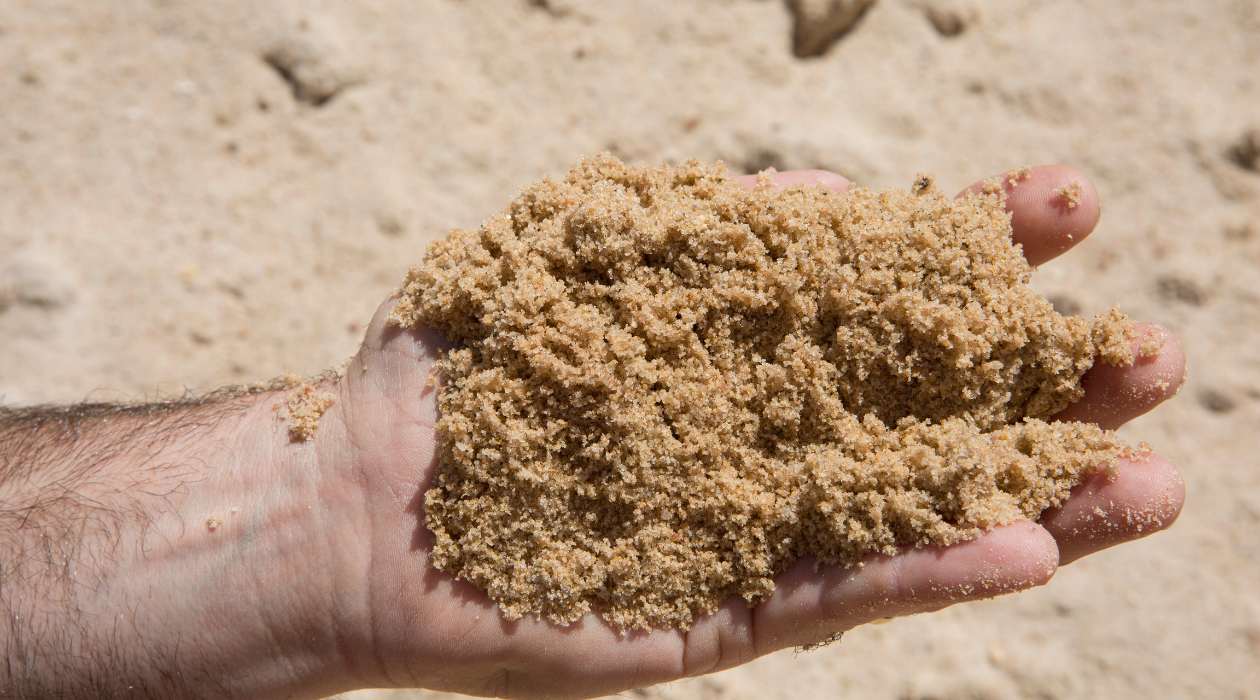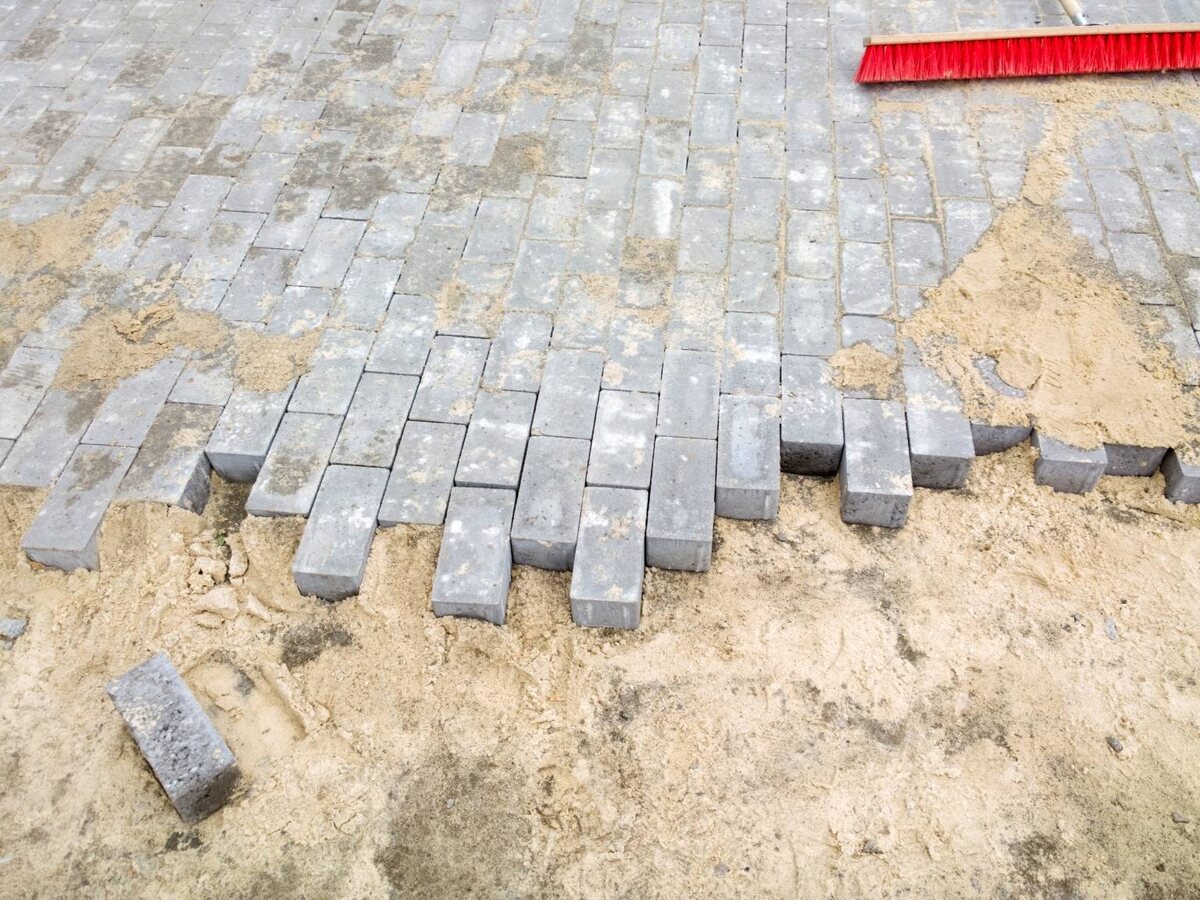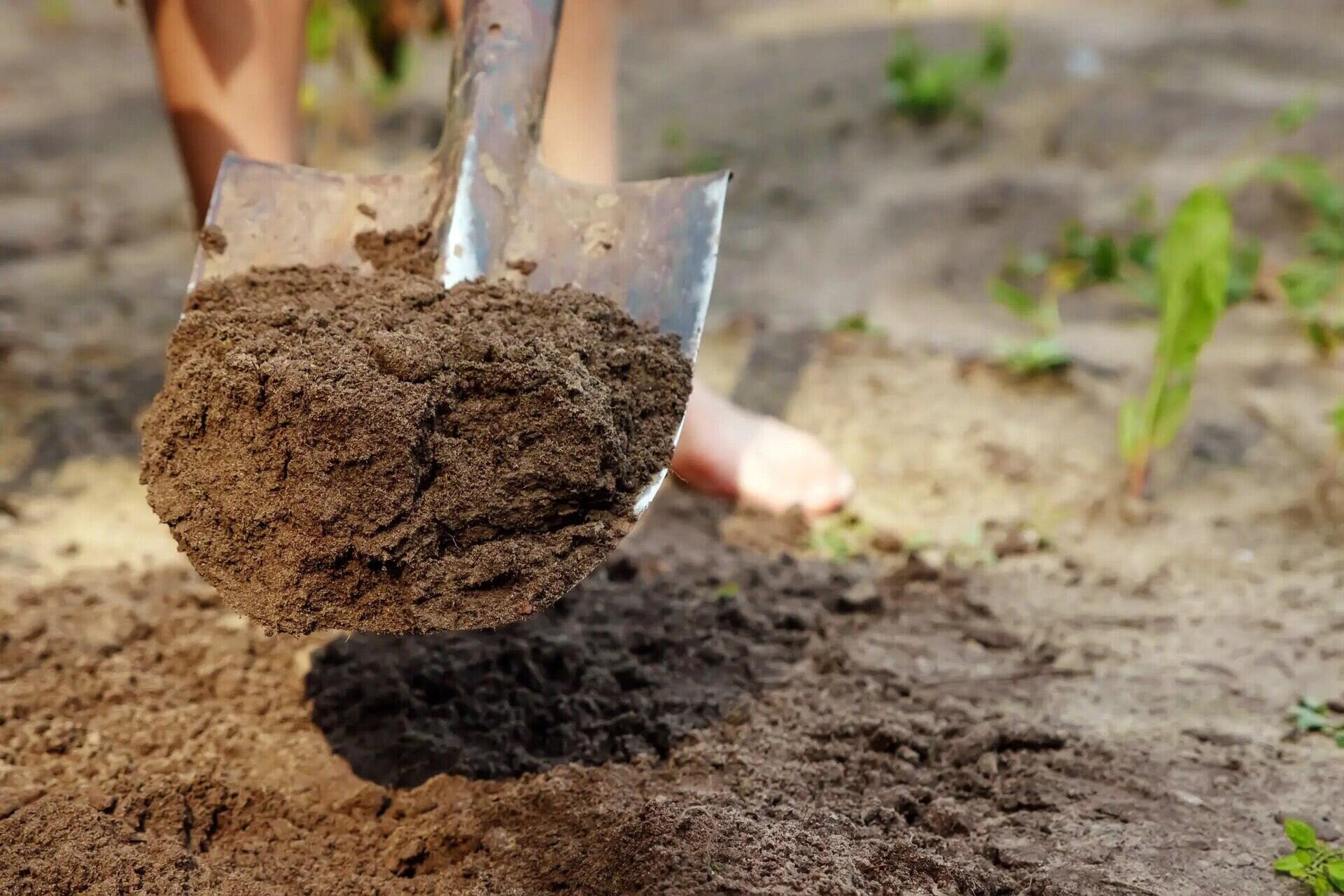Home>diy>Building & Construction>What Is Construction Sand


Building & Construction
What Is Construction Sand
Modified: January 19, 2024
Learn about construction sand and its role in building construction. Find out the different types of sand used and its importance in various construction projects.
(Many of the links in this article redirect to a specific reviewed product. Your purchase of these products through affiliate links helps to generate commission for Storables.com, at no extra cost. Learn more)
Introduction
Welcome to the world of construction, where sand plays a crucial role in creating strong and durable structures. Construction sand, also known as building sand or sand aggregate, is a versatile material commonly used in a variety of construction applications. From laying the foundations of buildings to creating concrete and mortar mixtures, construction sand is an essential component that contributes to the overall strength and integrity of a project.
In this article, we will explore the definition, uses, properties, sources, extraction and processing methods, environmental impact, safety considerations, and alternatives to construction sand. By the end, you will have a comprehensive understanding of this vital construction material.
So, let’s dive into the world of construction sand and discover why it is so crucial in the building industry.
Key Takeaways:
- Construction sand, a crucial building material, must possess specific properties such as uniformity, compaction, and drainage capabilities to ensure the strength and stability of constructed elements.
- Responsible sourcing, environmental mitigation, and safety considerations are essential in the use of construction sand, while exploring alternatives like manufactured sand and recycled aggregates promotes sustainability in the construction industry.
Read also: 9 Superior Construction Sand For 2024
Definition of Construction Sand
Construction sand is a type of sand aggregate that is specifically graded and suitable for use in construction projects. It is derived from various sources, including rivers, quarries, and coastal areas, and is typically composed of fine particles ranging from 0.075 to 4.75 millimeters in size.
To meet the requirements of construction applications, construction sand undergoes a meticulous grading process to ensure uniformity in particle sizes. It is classified according to ASTM (American Society for Testing and Materials) standards, with common grades including fine sand, coarse sand, and specialized sands such as masonry sand and concrete sand.
Unlike other types of sand, such as beach sand or desert sand, construction sand is carefully selected and processed to possess specific characteristics that make it an ideal material for construction purposes. These characteristics include uniformity in particle size, good compaction properties, high load-bearing capacity, and excellent drainage capabilities.
Construction sand is typically free from organic impurities, such as silt, clay, and vegetation, which can negatively impact the structural integrity of buildings and infrastructure. Additionally, it should have minimal amounts of harmful substances, such as salts and chlorides, to prevent corrosion in steel reinforcement.
The quality and suitability of construction sand for particular construction projects depend on several factors, including the specific requirements of the project, regional availability, and local building codes and regulations. Therefore, it is essential to select the right type of construction sand based on these considerations to ensure the success of construction endeavors.
Uses of Construction Sand
Construction sand is a versatile material that finds application in a wide range of construction projects. Its unique properties make it a valuable component in various construction processes. Here are some of the common uses of construction sand:
- Concrete Production: Construction sand is a fundamental ingredient in the production of concrete. It forms the bulk of the aggregate used in concrete mixtures, providing strength, stability, and durability to the final product. The sand binds with cement and water to create a solid and load-bearing material that is essential for constructing foundations, walls, floors, and other structural elements.
- Mortar Mixtures: Construction sand is mixed with cement and water to create mortar, a paste-like substance used for binding bricks, blocks, and stones in masonry constructions. Mortar provides cohesion and adhesion between individual units, ensuring the stability and integrity of walls, arches, and other masonry structures.
- Paving and Pathways: Construction sand is commonly used as a base material for constructing roads, sidewalks, driveways, and pathways. Its compactability and stability make it an excellent choice for supporting heavy traffic loads and providing a durable surface for vehicles and pedestrians.
- Landscaping: Construction sand is often utilized in landscaping projects to level the ground, create a stable base for outdoor structures, and improve the drainage of soil. It can be used to fill trenches, create custom slopes, or as a bedding material for pavers, retaining walls, and other landscape features.
- Playground and Sports Surfaces: Construction sand is an essential component in the construction of playgrounds and sports surfaces. It is used to create impact-absorbing surfaces for playgrounds, ensuring the safety of children. Additionally, it is employed as a cushioning layer in athletic fields, providing a stable and shock-absorbing surface for various sports activities.
- Filter Media: Construction sand is utilized as a filter medium in various applications, including water treatment plants, swimming pools, and septic systems. Its fine particles allow for efficient filtration by removing impurities and contaminants from water, ensuring its cleanliness and usability.
- Erosion Control: Construction sand is employed in erosion control measures, such as sandbags and sand-filled barriers, to prevent soil erosion in coastal areas, riverbanks, and other vulnerable landscapes. It acts as a barrier against water currents and helps stabilize the soil, protecting structures and preventing land degradation.
These are just a few examples of the many uses of construction sand in the building industry. Its versatility and reliability make it an indispensable material for constructing safe, sturdy, and resilient structures.
Properties of Construction Sand
Construction sand possesses several distinctive properties that make it an ideal material for various construction applications. Understanding these properties is crucial for choosing the right type of sand for specific projects. Here are the key properties of construction sand:
- Particle Size Distribution: Construction sand is graded and categorized based on the size of its particles. It typically falls within a specific range of particle sizes, with fine sand ranging from 0.075 to 2.36 millimeters and coarse sand ranging from 2.36 to 4.75 millimeters. The particle size distribution determines the compactability, stability, and workability of the sand in construction processes.
- Uniformity: Construction sand should have a uniform distribution of particle sizes, with minimal variation. This uniformity ensures consistent performance and compaction, leading to enhanced strength and stability in the final construction.
- Compactability: Construction sand should possess good compactability, allowing it to settle and form a dense and stable base when used in foundations, roads, and other load-bearing structures. It should be able to withstand the pressure exerted by heavy loads without excessive settlement or deformation.
- Load-Bearing Capacity: Construction sand should have a high load-bearing capacity to support the weight of structures. It should be able to distribute and transfer loads evenly, preventing excessive stress concentration on specific points. A sand with a high load-bearing capacity ensures the structural integrity and longevity of the constructed elements.
- Drainage Capabilities: Construction sand should have excellent drainage properties, allowing water to pass through it efficiently. This feature is essential in preventing water accumulation and potential damage caused by waterlogging or hydrostatic pressure. The proper drainage of water helps maintain the stability and durability of the construction.
- Chemical Composition: Construction sand should be free from harmful substances that could impact the properties of the construction materials or compromise the structural integrity. It should have minimal organic impurities, salts, chlorides, and other contaminants that can lead to corrosion, deterioration, or chemical reactions.
- Abrasion Resistance: Construction sand should be resistant to abrasion, especially in applications where it comes into contact with moving objects or frequent mechanical stresses. Abrasion resistance ensures the long-lasting quality and appearance of structures, preventing wear and tear over time.
These properties collectively contribute to the overall performance and durability of construction sand in various construction applications. It is crucial to consider these properties when selecting sand for specific projects to ensure optimal results and long-term structural integrity.
Sources of Construction Sand
Construction sand is sourced from various natural deposits, primarily from rivers, quarries, and coastal areas. The availability and suitability of sand sources can vary depending on the geographic location and local regulations. Here are the main sources of construction sand:
- River Deposits: Rivers are significant sources of construction sand. Over time, rivers erode rocks and minerals, carrying sediments downstream. These sediments, consisting of sand and other particles, accumulate along the riverbeds and create naturally replenishing sources of construction sand. River sand is known for its desirable qualities, such as fine particle size and rounded shape, making it suitable for a wide range of construction applications.
- Quarries: Quarries are where sand is extracted from the earth’s crust. These locations are typically rich in sand deposits that have been formed through geological processes over thousands of years. Quarries are carefully managed to ensure sustainable extraction practices while minimizing environmental impact. Sand from quarries is often crushed and screened to meet specific grading requirements for construction purposes.
- Coastal Areas: Coastal areas, such as beaches and dunes, can be sources of construction sand. The movement of ocean currents and wave action causes coastal erosion, leading to the accumulation of sand along the shoreline. However, it is important to note that not all coastal sand is suitable for construction due to its high salt content. Coastal sand meant for construction purposes often undergoes a washing process to remove salt and other impurities.
- Recycled and Manufactured Sand: In some cases, construction sand may be derived from recycling processes or manufactured from other materials. Recycled sand is obtained from construction and demolition waste, where the sand is sorted, cleaned, and processed for reuse. On the other hand, manufactured sand is produced by crushing rocks or quarry stones into fine particles that meet the required grading specifications.
- Imported Sand: In regions where local sources of construction sand are limited, sand may be imported from other locations. This is particularly common in landlocked areas or regions with specific construction sand demands that cannot be met locally. Imported sand undergoes rigorous quality control checks and meets the necessary standards to ensure its suitability for construction projects.
It is important to select sand from reliable sources that adhere to sustainable and responsible mining practices. Additionally, considering the distance and transportation costs associated with different sources is essential to maintain cost-effectiveness and minimize environmental impact.
When choosing construction sand, look for a well-graded, clean, and angular sand that is free of organic materials and clay. This type of sand will provide better compaction and stability for your construction projects.
Read more: What Type Of Sand For Lawns
Extraction and Processing of Construction Sand
The extraction and processing of construction sand involve several stages to ensure its quality and suitability for various construction applications. Here is an overview of the typical process:
- Extraction: Construction sand is extracted from natural deposits through various methods, depending on the source. In river or inland sand mining, large-scale dredging equipment is used to remove sand from the riverbed or sediment deposits. Excavators or front-end loaders are commonly employed in quarry mining to extract sand from the earth’s crust. For coastal sand mining, specialized equipment such as suction dredgers may be used to extract sand from the seafloor.
- Transportation: After extraction, the sand is transported to the processing plants using trucks, rail, or conveyor belts. This stage requires careful handling to prevent contamination or loss of sand particles.
- Screening and Washing: At the processing plant, the extracted sand undergoes screening to separate larger rocks, debris, and other impurities. This is usually done using vibrating screens or sieves of various mesh sizes. The sand may also undergo washing to remove excess clay, silt, and organic matter. Washing is typically done through a combination of water, agitation, and screening to achieve the desired cleanliness and uniformity.
- Grading and Classification: Once the sand is clean, it is graded and classified according to particle sizes using a series of sieves or classifiers. This process ensures that the sand meets the required specifications for different construction applications, such as concrete production or masonry work. Proper grading is crucial to achieve optimal strength, workability, and compaction properties in the final construction material.
- Storage: After processing, the construction sand is stored in designated areas, either in stockpiles or silos, to await distribution. Proper storage conditions are maintained to prevent contamination or degradation of the sand before it is used in construction projects.
It is essential for sand extraction and processing operations to follow sustainable practices and comply with environmental regulations. This includes the implementation of measures to mitigate the environmental impact, such as minimizing disruption to ecosystems, managing sedimentation, and restoring disturbed areas.
By following these extraction and processing practices, construction sand can be transformed into a high-quality building material that contributes to the strength and longevity of the structures it is used in.
Environmental Impact of Construction Sand Extraction
The extraction of construction sand can have significant environmental implications if not managed properly. It is crucial to understand and mitigate these impacts to ensure the sustainability of sand mining operations. Here are some of the key environmental concerns associated with construction sand extraction:
- Habitat Destruction: Sand mining can result in the destruction or alteration of natural habitats, including riverbeds, coastal areas, and ecosystems surrounding extraction sites. This can disrupt the balance of ecosystems and adversely affect wildlife populations, vegetation, and aquatic habitats.
- Sedimentation and Erosion: Sand extraction from rivers and coastal areas can cause increased sedimentation downstream, leading to changes in water flow patterns and increased erosion. Sedimentation can also smother aquatic habitats and affect water quality, impacting aquatic life and biodiversity.
- Water Depletion: Sand extraction activities often involve large quantities of water for washing and processing sand. If not properly managed, this can lead to excessive water usage and depletion of local water sources, negatively impacting nearby communities, ecosystems, and water availability for other uses.
- Water Pollution: Improper handling of sand extraction wastewater or inadequate sediment control measures can result in water pollution, as sediment-laden water may be discharged back into rivers or other water bodies. This can impair water quality, harm aquatic life, and impact downstream ecosystems.
- Loss of Biodiversity: Sand mining can lead to the destruction or fragmentation of habitats, resulting in the loss of biodiversity and native plant and animal species. The disruption of ecosystems can have long-lasting impacts on the overall ecological balance and the services they provide, such as water filtration and carbon sequestration.
- Air Pollution: Dust emissions from sand mining and processing activities can contribute to air pollution, affecting air quality and human health in nearby communities. Inhalation of airborne particles can lead to respiratory issues and other health concerns.
- Effects on Coastal Stability: Coastal sand mining can exacerbate coastal erosion and destabilize the shoreline. Removing sand from beaches or dunes can compromise their natural protective function against coastal storms and sea-level rise.
To mitigate these environmental impacts, responsible sand mining practices should be adopted. This includes implementing appropriate sediment control measures, designing extraction sites to minimize ecological disruption, monitoring and managing water usage, employing reclamation and rehabilitation efforts, and adhering to environmental regulations and guidelines.
Furthermore, initiatives such as sustainable sourcing, recycling and reusing construction sand, and promoting alternatives like manufactured sand can help reduce the demand for natural sand extraction and minimize its environmental footprint.
By prioritizing sustainable practices and minimizing environmental impacts, the construction industry can continue to utilize construction sand while preserving ecosystems and safeguarding the planet for future generations.
Safety Considerations in Handling Construction Sand
While construction sand is a valuable material, it is essential to prioritize safety when handling and using it to mitigate the risk of accidents and injuries. Here are some key safety considerations to keep in mind:
- Personal Protective Equipment (PPE): Workers involved in handling construction sand should wear appropriate personal protective equipment. This typically includes safety goggles or glasses to protect the eyes from flying particles, gloves to safeguard the hands, and respiratory protection when working in dusty environments.
- Manual Handling: When lifting or moving bags, containers, or bulk quantities of construction sand, proper manual handling techniques should be followed. This includes using proper lifting techniques, avoiding excessive bending or twisting motions, and utilizing mechanical aids, such as wheelbarrows or forklifts, when necessary to reduce the risk of strain or musculoskeletal injuries.
- Dust Control: Construction sand can generate dust particles during handling, which may pose respiratory hazards. Adequate measures should be taken to control dust, including using water sprays or dust suppression systems, as well as ensuring good ventilation in enclosed areas to minimize dust accumulation.
- Slip and Trip Hazards: Spilled or loose construction sand can create slip and trip hazards, particularly on smooth surfaces. It is important to keep work areas clean and clear of debris, regularly sweep sand spills, and use appropriate signage and barriers to alert workers and visitors about potential hazards.
- Working at Heights: If construction sand needs to be placed or accessed at elevated heights, appropriate fall protection measures should be in place. This may include the use of guardrails, safety harnesses, or other devices to prevent falls and protect workers from potential injuries.
- Storage: Proper storage practices should be followed to prevent injuries and accidents. Stacking sand bags or containers in a stable manner, placing them away from edges or high-risk areas, and ensuring proper labeling and signage can help minimize the risk of storage-related incidents.
- Equipment Safety: When using equipment such as loaders or conveyors to handle construction sand, operators should be trained in their safe operation and maintenance. Regular equipment inspections and maintenance protocols should be followed to ensure their proper functioning and reduce the risk of accidents.
Additionally, proper training and awareness programs should be implemented to educate workers about the potential risks associated with handling construction sand and the necessary safety protocols to follow. This includes regular safety meetings, providing clear instructions, and emphasizing the importance of personal accountability when it comes to safety.
By prioritizing safety and implementing these considerations, the risks associated with handling construction sand can be significantly minimized, creating a safer work environment for everyone involved in construction projects.
Alternatives to Construction Sand
While construction sand is widely used in the building industry, there are alternative materials available that can provide similar or even improved performance in certain applications. These alternatives offer potential benefits such as reduced environmental impact, enhanced durability, and increased resource sustainability. Here are some common alternatives to construction sand:
- Manufactured Sand: Also known as crushed sand or artificial sand, manufactured sand is produced by crushing rocks or quarry stones to the desired particle size. Manufactured sand has consistent particle sizes and can be tailored to meet specific grading requirements. It can be an effective substitute for natural sand in applications such as concrete production, masonry work, and road construction.
- Recycled Aggregates: Recycled aggregates, derived from construction and demolition waste, offer an environmentally friendly alternative to traditional construction sand. These aggregates are processed and graded to meet certain specifications and can be used in various construction applications, including concrete production, base layers for roads and pathways, and landscaping projects. Using recycled aggregates helps reduce the demand for natural resources and lowers the amount of waste sent to landfills.
- Quarry Dust: Quarry dust, also known as stone dust or crusher dust, is a byproduct of stone crushing operations. It consists of fine particles and can be used as a substitute for sand in certain construction applications. Quarry dust is commonly used as a partial replacement for natural sand in concrete mixes, mortar, and plastering, providing similar strength and workability properties.
- Fly Ash: Fly ash is a byproduct of coal combustion in thermal power plants. It is a pozzolanic material that can be used as a supplementary cementitious material in concrete production. When used as a partial replacement for cement, fly ash improves the workability, durability, and long-term strength of concrete. Its use can reduce the requirement for sand in concrete mixes.
- Quartz Sand: Quartz sand is a type of industrial sand composed of quartz particles. It is available in various sizes and can be used in construction applications where the properties of natural sand are required. Quartz sand is often used in specialized concrete mixtures, tile adhesives, and sports surfaces.
- Expanded Clay or Shale: Expanded clay or shale, also known as lightweight aggregate, is a versatile material that can be used as a substitute for sand in lightweight concrete mixtures. It offers excellent thermal insulation properties and is suitable for applications where reduced weight is desirable, such as precast elements, lightweight masonry, and green roof systems.
It is important to note that the suitability and availability of alternative materials may vary depending on location and specific project requirements. Consulting with construction professionals and considering regulatory guidelines can help determine the most appropriate alternative to construction sand for a particular application.
By exploring and embracing these alternative materials, the construction industry can move towards more sustainable practices and reduce its dependency on natural sand resources.
Read more: What Grit Sandpaper For Sanding Cabinets
Conclusion
Construction sand is an essential building material that plays a vital role in the construction industry. From supporting the foundation of structures to creating durable roads and pathways, construction sand is a versatile material with numerous applications. Understanding its properties, sources, extraction and processing methods, as well as its environmental impact, is crucial for responsible and sustainable use.
While construction sand is widely used, it is important to consider alternatives and explore more sustainable options. Manufactured sand, recycled aggregates, quarry dust, fly ash, and other materials can serve as viable substitutes for natural sand in various construction applications. Adopting these alternatives can not only help preserve natural resources but also contribute to reduced environmental impact and improved resource sustainability.
It is equally important to prioritize safety when handling construction sand. Implementing proper safety protocols, using personal protective equipment, and following best practices for manual handling and equipment operation minimize the risk of accidents and ensure the well-being of workers.
As the construction industry continues to evolve, balancing the need for construction sand with environmental considerations and safety measures is essential. Embracing sustainable sourcing, recycling practices, and exploring innovative solutions will contribute to a more environmentally friendly and socially responsible construction sector.
In conclusion, construction sand is a vital component in the building industry, but it is crucial to use it responsibly and consider alternative options to reduce environmental impact. By doing so, we can create a more sustainable future while constructing safe, durable, and resilient structures.
Frequently Asked Questions about What Is Construction Sand
Was this page helpful?
At Storables.com, we guarantee accurate and reliable information. Our content, validated by Expert Board Contributors, is crafted following stringent Editorial Policies. We're committed to providing you with well-researched, expert-backed insights for all your informational needs.














0 thoughts on “What Is Construction Sand”